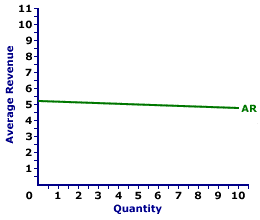
|
|
DI: The abbreviation for disposable income,which is the total income that can be used by the household sector for either consumption or saving during a given period of time, usually one year. This is the income left over after income taxes and social security taxes are removed and government transfer payments, like welfare, social security benefits, or unemployment compensation are added. Because consumption and saving are important to our economy for short-run stability and long-run growth, pointy-headed economists like to keep a close eye on disposable personal income. Disposable income is reported quarterly (every three months) in the National Income and Product Accounts maintained by the Bureau of Economic Analysis.
Visit the GLOSS*arama
|
|


|

|
                           AVERAGE REVENUE CURVE, MONOPOLISTIC COMPETITION: A curve that graphically represents the relation between average revenue received by a monopolistically competitive firm for selling its output and the quantity of output sold. Because average revenue is essentially the price of a good, the average revenue curve is also the demand curve for a monopolistically competitive firm's output. Monopolistic competition is a market structure with a large number of relatively small firms that sell similar but not identical products. Each firm is small relative to the overall size of the market such that it has some market control, but not much. In other words, it can sell a wide range of output at a narrow range of prices. This translates into a relatively elastic demand curve. If a monopolistically competitive firm wants to sell a larger quantity, then it must lower the price.The average revenue curve reflects the degree of market control held by a firm. For a perfectly competitive firm with no market control, the average revenue curve is a horizontal line. For firms with market control, such as monopolistic competition, the average revenue curve is negatively-sloped. Average Revenue Curve,
Sandwich Style |  |
The average revenue curve for Manny Mustard is displayed in the exhibit to the right. Key to this curve is that Manny Mustard is a monopolistically competitive seller of sandwiches and thus faces a negatively-sloped demand curve. Larger quantities of output are only possible with lower prices.The vertical axis measures average revenue and the horizontal axis measures the quantity of output (number of sandwiches). Although quantity on this particular graph stops at 10 sandwiches, it could go higher. This curve indicates that if Manny Mustard sells 1 sandwich (at $5.20 per sandwich), then average revenue is $5.20 per sandwich. Alternatively, if he sells 10 sandwiches (at $4.75 per sandwich), then average revenue in is $4.75 per sandwich. For Manny Mustard the average revenue curve is also the demand curve. The curve is negatively sloped, meaning that larger quantities of output result in less average revenue. Although this average revenue curve, and preceding table of average revenue numbers, is based on the production activity of Manny Mustard, a well-known monopolistically competitive firm, they apply to any firm with market control. Monopoly and oligopoly firms that also face negatively-sloped demand curves generate comparable average revenues.

Recommended Citation:AVERAGE REVENUE CURVE, MONOPOLISTIC COMPETITION, AmosWEB Encyclonomic WEB*pedia, http://www.AmosWEB.com, AmosWEB LLC, 2000-2024. [Accessed: April 27, 2024].
Check Out These Related Terms... | | | | | | | | |
Or For A Little Background... | | | | | | | | | | | |
And For Further Study... | | | | | | | | |
Related Websites (Will Open in New Window)... | | | |
Search Again?
Back to the WEB*pedia
|



|

|
RED AGGRESSERINE
[What's This?]
Today, you are likely to spend a great deal of time surfing the Internet trying to buy either a flower arrangement with daisies and carnations for your uncle or a coffee cup commemorating next Thursday. Be on the lookout for slightly overweight pizza delivery guys.
Your Complete Scope
This isn't me! What am I?
|

|
|
The standard "debt" notation I.O.U. does not mean "I owe you," but actually stands for "I owe unto..."
|

|
|
"Nothing is a waste of time if you use the experience wisely. " -- Auguste Rodin, Sculptor
|

|
AEA
American Economic Association
|

|
|
Tell us what you think about AmosWEB. Like what you see? Have suggestions for improvements? Let us know. Click the User Feedback link.
User Feedback
|


|


